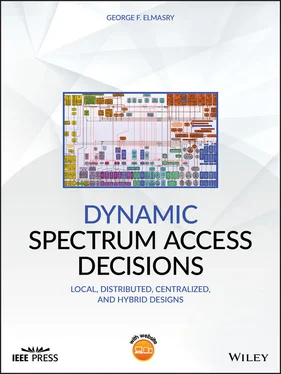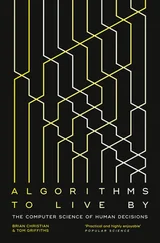1 ...8 9 10 12 13 14 ...52 4 4‐ Other information. This can include external systems and their use of spectrum, and terrain information. Terrain information can help the DSA decision‐making process differentiate between interference from other systems versus degraded signal due to terrain effects as well as evaluating a spectrum assignment before it is executed.
The DSA decision‐making process can use two important categories of information in its information repository among other information categories. The first category of information is the spectrum resources pool, which can be changed dynamically with time. The DSA decision‐making process uses and updates the spectrum resources pool according to spectrum assignments. The second category of information is the knowledge base obtained from fusing spectrum sensing information. A good design of DSA as a set of cloud services should be able to use objective DSA metrics to measure the effectiveness of past decisions and should be able to adapt future decisions based on the behavior measured through the DSA metrics. Adapting future decisions will rely on ubiquitous changes in policies, rule sets, and configuration parameters, as further explained in Chapter 5.
The cognitive engine implementation of the DSA decision‐making process can perform many simultaneous tasks. Consider, for example, the presence of different propagation models within the information repository. A process within the cognitive engine can use geolocation information and terrain data as shown in Figure 1.4while analyzing spectrum sensing information to decide the best propagation model that can be used at a given time. As geolocation information is updated, another part of the terrain data may be used, which may require changing the propagation model. The cognitive engine continues to recommend the best propagation model to be used to analyze the effectiveness of a potential spectrum assignment before it is assigned. This makes the DSA decision‐making process able to have a level of confidence for any spectrum change and be able to recommend the best spectrum assignment in cases where more than one option of spectrum assignment can be considered.
1.5 The Pitfalls of DSA Decision Making
DSA design must avoid some pitfalls that can render the design suboptimal. These pitfalls include the following:
1 Failure to see a complete picture of the involvedness of the DSA decisions. DSA designs that ignores the role of important information, constraints, and the intended use of the managed networks can be suboptimal.
2 Failure to consider the hierarchy of DSA decisions. This can result in a rippling decision‐making process and diminishing throughput efficiency.
3 Failure to take advantage of all available information. The presence of augmented sensing hardware that gives rich information on wideband spectrum sensing can lure the designer to ignore the value of other information such as same‐channel in‐band sensing. Also, one must be cognizant of the relevance of the collected spectrum sensing information. Old sensing information must be discarded as it can be harmful to use since it does not reflect the current state of spectrum usage. As Chapter 8 shows, making co‐site interference information available to the DSA decision‐making process and taking into consideration the different types of co‐site interference information can decrease rippling and ensure better optimization of the spectrum resources utilization.
4 Overcomplicating the decision‐making process. The use of cognitive techniques is powerful and is needed in the DSA design. However, developing a complex machine learning technique where stochastic models can give the best decision is a pitfall that must be avoided. This type of overcomplication can occur in the local decision‐making process where physical layer metrics are the reference for some decisions. Using stochastic models can render the best results a machine learning approach can give. Reducing the complication of DSA decision making can also include overlaying or superimposing decisions in the order of their precedence. As Chapter 8 explains, co‐site interference information can be considered as a second order of spatial separation that is only considered after the first order of spatial separation of frequency assignments is completed. This overlay of decision making reduces complexity while using later, less important decisions to fine‐tune earlier more important decisions.
5 Design rigidity. DSA is evolving and a good design should consider incremental increases in DSA capabilities. One important approach is to leverage standardized interfaces such as the DySPAN standards covered in Part 4 of this book instead of utilizing proprietary interfaces. Standardized interfaces allow leverage of new capabilities with minimal integration efforts. Also, the overlay of decision‐making techniques explained above can lead to reducing design rigidity. DSA as a set of cloud services can add new services that fine‐tune the outcome of existing services for better optimization of spectrum resources without the need to modify earlier capabilities.
6 Ignoring the role of DSA policies. Overlooking how to tie cognitive decisions to policy automation can render a system unusable. This pitfall can result in violations of established rules and the cognitive engine making some decisions that should be avoided. This is specifically critical with military communications systems where DSA policies have to reflect the commander's intent while being ubiquitous.
7 Not considering the need for decision hierarchy. Very often designers of a distributed MANET focus on cooperative decisions and pay little attention to decisions that can be or should be made locally. Similarly, a designer of heterogeneous networks DSA may ignore the need for a centralized arbitrator.
8 Ignoring decision fusion and abstraction. When spectrum sensing information is shared in a distributed or centralized manner, fusing and abstracting the shared information is needed to reduce the control traffic volume. With distributed cooperative and centralized decision‐making solutions, locally made decisions can be shared with an abstracted version of spectrum sensing information if needed. 6
The chapters of this book are organized to help the reader make design decisions that can optimize the performance of DSA services and avoid the pitfalls mentioned above. For example, if you are designing a distributed cooperative DSA system, there could be room for local decisions and optimum local fusion and optimization of DSA control traffic volume. If you are designing a centralized DSA system, optimum hierarchical decision making can lead to more efficient spectrum management of heterogeneous networks than relying mainly on centralized decisions.
DSA solutions can differ drastically from one system to another. However, there are common foundations that can be used in any DSA design approach. The goal is always the same: optimize the use of a given pool of spectrum resources dynamically and react to changes in environments. With this book laying some theoretical foundations of DSA design, addressing the most generic model of DSA, and then showing with case studies how this generic model can be applied to different cases, the reader should be able to obtain knowledge on how to approach DSA and how to create design concepts for any system under consideration. The separation of the physical layer aspects of DSA from the cognitive engine aspects in this book should help the reader address the design aspects of the physical layer separate from the design aspects of cognitive engines such that DSA can be applied to noncognitive systems and cognitive systems and the design can address any system requirements and boundaries.
As the reader goes through the rest of this book, the many facets of DSA will become clearer and the reader will see how a large system of heterogeneous networks may require using heuristic approaches, overlaying of decisions‐making processes, and considering many aspects and tradeoffs to design an effective system.
Читать дальше












